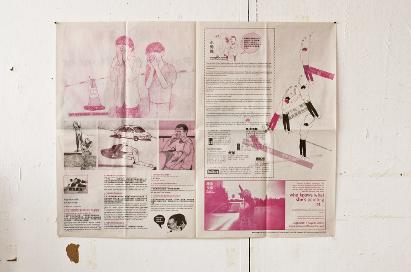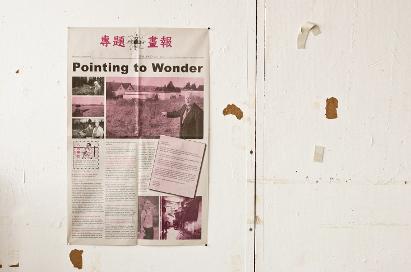

Pointing to Wonder is a newspaper with a special theme published by Beatrix Pang. This issue is about finger-pointing pictures which shown on the newspapers in Hong Kong, Germany and other places in the world. What do these images tell exactly? The drawings are as well telling "something" beyond or behind the stories from the newspapers. Dialogues are initiated by Beatrix Pang with artist Peter Piller (Germany) and Sushan Chan (Hong Kong).
手指指-不同人物場景的照片皆有人手指指著空無之處,這照片在說甚麼?這份獨立出版小報講述的,是有關香港及德國兩地的報章一些影象類同但意義不同的照片,這表達了兩地文化對此類影像在大眾媒介中的使用,也同時反映出影像詮譯的某種失誤。
Concept by the author
The concept of this column is taken from a pile of newspaper clippings. Every time I read the newspaper, there are always certain images that draw my attention.
I have developed a habit of collecting them. I have collected various types of images including these pictures here, from ‘Pointing to Wonder’, which are one of the categories. Looking at these images, I am attracted by the faces of the characters who are pointing in a direction with their fingers. I ask myself, “What happened there? What are they pointing at?” After reading the captions, my brain starts to invent stories. “Right... That is what is happening..” When I look at the pictures I am easily drawn into the blind spot by following the pointing finger. Roland Barthes wrote in Camera Lucida, “In order to designate reality, Buddhism says sunya, the void; but better still: tahata, as Alan Watts has it, the fact of being this, of being thus, of being so; tat means that in Sanskrit and suggests the gesture of the child pointing his finger at something and saying: that, there it is, lo! but says nothing else.”[1] When I look at these images, does that mean so to me? They all seem to simply remark that something had happened.
In Camera Lucida, Barthes explained Studium and Punctum. Studium is a Latin word, which means ‘study’, that is applied to a thing, and meaning a taste for someone, or a kind of general enthusiastic commitment without special acuity. Punctum is a “detail”, a partial object on a photograph. In this case, I assume these finger-pointing pictures are meaningless. Since they are shown in the newspaper to report particular incidents, they have no description and detail on the pictures telling the reader what exactly happened. The imagination is there, but there is lack of information provided to know what happened in the incident.
‘That-has-been’ seems the only thing shown in these pictures. The pictures of ‘Pointing to Wonder’ give us an alternative way of reading news. This style also proves a method of news reporting that is chosen by the local news media.
About the author
Beatrix Pang, a Hong Kong-born visual artist and cultural practitioner, she has been studied design and
photography in both local and international art institutes, she is currently a researcher on visual culture study.
創作概念
著手整理「手-指-指」這個專欄的想法,源自每天收集得來的剪報發現。
每當翻閱報章,看到某些圖片時,我會把它們剪下收集起來;而「手-指-指」 類別的新聞圖片是其中的一種。單看這些影像,會先被當中的人物吸引,他們「七情上面」的指著那「某處」,我會問,究竟那手指著的某處代表著甚麼呢?這些圖片告訴我們怎樣的信息呢?再看圖片的標題,腦袋自然地在編寫著故事... 啊...是這樣的嗎?當看著這些圖片,視線都因看到手指的那處而落入盲點時,我們其實還看得到甚麼呢?這讓我聯想起羅蘭.巴特在《明室攝影札記》一書中描述他對看照片時的看法:「佛家稱現實為空(Sunya),不過本無(tathata)一字更妙,意指如是之實、那樣之實、那個之實,tat在梵文中指那個,令人想及小孩子伸指點物的手勢,說道:『它、那、那個!(Ta, Da, Ca!)』總有一張照片在手勢那端,照片說:『那個,就是那個,就是那樣!』但不多言其他。」[1] 所以,我們看到的這些影像所表現的,其實只是不過如此的嗎?而這些「手-指-指」圖片看起來也像是訴說著一些曾經發生或出現過的人、事和物。
我也想到巴特後來所談到「知面(Studium)」和「刺點(Punctum)」,即是照片上的畫面的描述和所引起的投注,以及當中所要訴說的重點或引起好奇的點,當然對巴特來說「刺點」實是跟回憶、情感和照片所拍下的瞬間有關。故此,我們可以嘗試理解,這些 「手-指-指」圖片其實是一種毫無意義的圖像表達,因為作為新聞圖片,它們既沒有提供畫面上的內容,也沒有對指著的那點作細節的描述,看到的只剩下指著的姿勢,除了提供讀者畫面以外的想像,對了解畫面的內容可以說是沒有幫助的。「此曾在」似是這類圖片唯一所說的。
如此看來,這些「手-指-指」的圖片不失為另類閱讀新聞圖片可能性的同時,也展示著本地報章報導事件時所選擇的一種「方法」。
關於作者
彭倩幗,本地視覺藝術及文化從業者,曾在本地和海外接受設計及攝影藝術教育,現時正進行視覺文化研究工作。